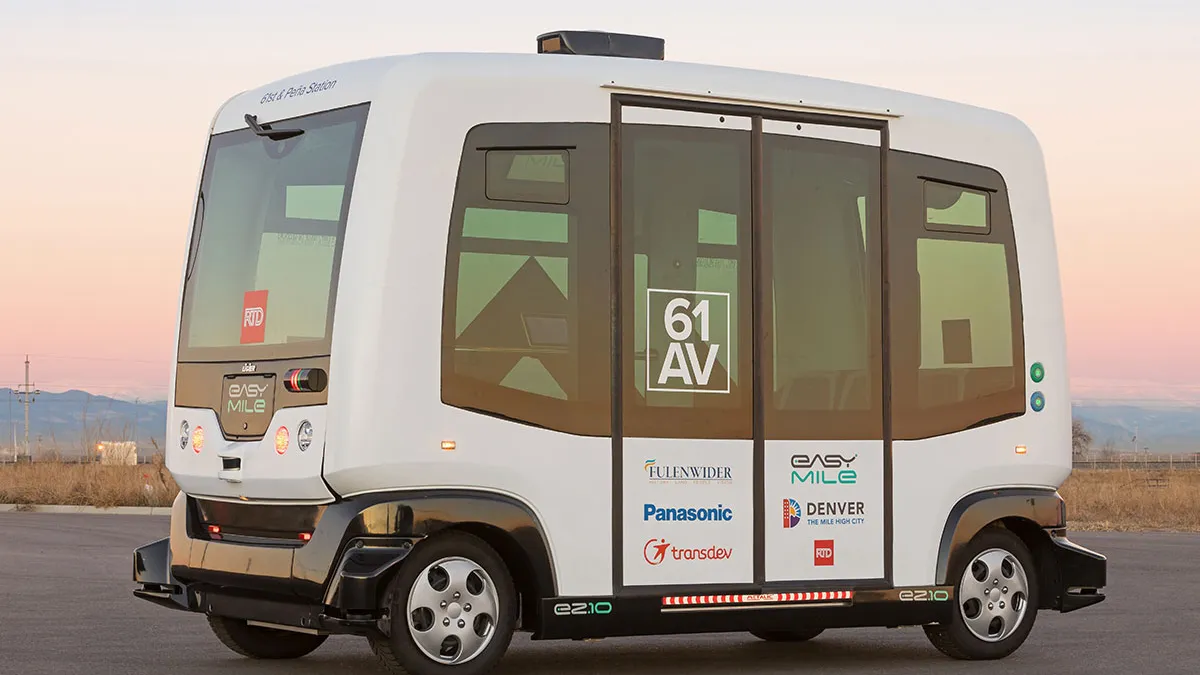UPDATE, Jan. 31, 2019: A long-awaited autonomous shuttle began free service in Denver this week near the Denver International Airport, according to Denver Public Works.
Denver’s first driverless shuttle is on the road folks! Just another mobility option for residents to move around the city and create more equity and accessibility. Check out the inaugural ride. ????@RideRTD @DenPublicWorks @Easy_Mile @panasonic pic.twitter.com/vZt4Kprvw5
— Michael B. Hancock (@MayorHancock) January 29, 2019
The 61AV pilot project, which is spearheaded by the Regional Transportation District (RTD), will run along a route from the 61st and Pena transit station to the Panasonic and EasyMile offices. The EasyMile vehicles will run at speeds of up to 15 mph, and while there's no "driver" on board, an RTD "ambassador" will be present on each ride. Each vehicle is 100% electric and can fit up to 12 passengers.
"Technology is advancing and changing so quickly that everyone is getting up," Denver Mayor Michael Hancock said at the event, as reported by CBS Denver. "Cities all around the world are getting up on these opportunities to make ourselves better, smarter, faster."
Dive Brief:
- Autonomous shuttles are now being tested in Denver, with the hope of rolling them out into full operation in the spring, according to The Denver Post.
- The six-seat shuttle would help with first mile/last mile public transportation connections. The first route will transport passengers between a Denver train station and a nearby bus stop, which also is close to many office buildings.
- Colorado Governor John Hickenlooper declared Monday as "Connected and Autonomous Vehicle Day," during an event when he and Denver Mayor Michael Hancock took the inaugural trip on the driverless shuttle in Denver.
Dive Insight:
Governor Hickenlooper has been pushing hard to make sure his state is on the forefront of the autonomous vehicle (AV) trend. State legislators recently passed a law legalizing AV travel on Colorado's roads, as long as operators obey all of the existing rules of the road.
Denver is among the many municipalities working to add driverless shuttles. Gainesville, FL plans to launch one in the spring, as does Tampa. But last month Las Vegas became the first city in the country to actually put an autonomous shuttle into operation on public streets.
Most municipalities are going through months of testing to ensure that the vehicles' cameras, radar and LiDAR can adequately maneuver them throughout cities and respond to hazards. That's wise considering the high-profile accident that occurred the day the Las Vegas shuttle began service. A human driver was at fault for backing into the autonomous shuttle, which stopped cold when it sensed a road hazard. A similar stopping situation happened during Denver's shuttle test this week, when the vehicle immediately halted upon sensing a tumbleweed blowing across the road.
AV designers say the shuttles did exactly what they were supposed to; they're designed to stop as soon as they sense danger. But in some situations, as human drivers know, it's safer to move out of the way instead of stop cold. Incidents like these prove that AV technology still is in its infancy and the machines still have much learning to do. The testing currently taking place also researches human interactions with AVs, which is a major factor in safely introducing the technology into the public space.
As opposed to the Las Vegas shuttle, which largely serves tourists in the city's downtown, Denver's shuttle service will focus on locals and easing their commutes. Although the first route connects a train station with a nearby bus station, expansion could eventually mean that passengers can use the shuttles to get from their homes to public transit stops.












